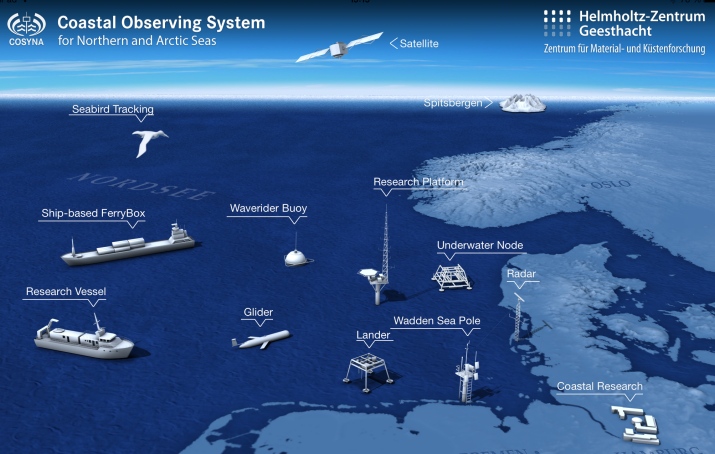Helmholtz-Zentrum Hereon, the Helmholtz association, universities and monitoring authorities provide virtual access (VA) to COSYNA data and services as part of the JERICO-RI.
COSYNA, short for the Coastal Observing System for Northern and Arctic Seas, is leading the way in deepening our comprehension of coastal environments, especially in the North Sea and Arctic coastal waters.

This ambitious undertaking is a collaborative effort, partnering with various entities within the Helmholtz association, universities, and monitoring authorities. This created synergy promotes cutting-edge scientific tools, and products, while opening up to the entire scientific community.
Furthermore, COSYNA is a crucial resource for authorities, industries, and the general public. This comprehensive support enables effective planning, management of routine tasks, and rapid responses to emergencies. Annually, between 100 and 700 GB of data are accessed from the data portal, reaching users in over seventy countries.
COSYNA is aligned with the Joint European Research Infrastructure Consortium for Coastal Observatories (JERICO-RI) objectives. This German initiative plays a vital role in delivering high-quality environmental data. COSYNA ensures open access to solutions and facilities, it empowers researchers and users within the coastal marine domain. The progress in technology, exemplified by the JERICO-S3 North Sea Pilot Super Site (PSS), enhances the seamless integration of high-quality data into a network of user-friendly tools and resources for stakeholders.
Through the support of JERICO-RI, COSYNA has undergone significant enhancements. The infrastructure has been significantly improved to meet industry standards, such as incorporating cutting-edge tools for data analysis.
Other improvement examples are a user-friendly WebApp developed to involve both researchers and the general public in coastal research content; advanced visualisation tools in place for the Tesperhude monitoring station in the Elbe; and HELMI, a new workflow, that integrates collected information into COSYNA’s data repositories.
COSYNA’s trajectory is distinguished by refinement and innovation. The transition from the original architecture to the new structures provided by the Helmholtz Coastal Data Center (HCDC) is on track for completion in 2024. Moreover, this coastal endeavour is set to enhance the data type accessibility.
Lastly, as COSYNA paves the way for a deeper understanding of coastal dynamics, its collaborative ethos and technology remain a pillar of advancement in coastal observation.

